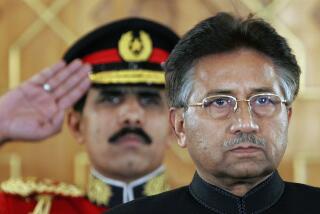Mogul Emperor’s Holy Aura Endures
- Share via
YANGON, Myanmar — After he died in exile under British captivity, the last Mogul emperor of India was buried and forgotten as a footnote in history.
Nearly 140 years later, Bahadur Shah Zafar is stirring new passions.
Since the discovery of his grave in 1991 in a quiet, leafy part of Yangon, the foreign king has been worshiped as a pir, or saint, by Myanmar’s Muslims as well as by people of other faiths.
The tomb has also become the focus of a diplomatic tussle between India and Pakistan, with both trying to assert themselves as the rightful inheritors of the emperor’s legacy. Pakistan, carved out of India as a homeland for Muslims when British colonial rule ended in 1947, maintains Zafar was a Muslim emperor rather than an Indian emperor.
“Who was this man called Zafar? He was a Mogul Muslim king who ruled India,” said Sahebzada Khan, a diplomat at the Pakistani Embassy.
But to the caretakers of Zafar’s mausoleum, he was simply a saint, a poet-scholar and a symbol of communal harmony.
“He was not only a king but also a saint. Even Buddhists, Hindus and Christians come here to seek his blessings,” said Abdul Rahim, a member of the committee that manages the mausoleum.
He said 20 to 25 people visit his tomb every day and sit at its foot to meditate, believing that wishes made there are fulfilled.
Zafar’s aura of holiness is due to his reputation as a scholar of Sufism, an ascetic movement within Islam. The folklore and the mystery surrounding his long-lost grave have added to the mysticism.
During his time, Zafar was one of the foremost poets of the Urdu language and an accomplished calligrapher. His “ghazals,” or poems, are still popular in India and Pakistan, the two countries that together formed the Mogul empire established in 1526. It ended when Zafar was dethroned by the British in 1858.
He died four years later at age 87 after penning his own epitaph in the form of a ghazal, a bitter lament against the British for leaving him to die in a foreign land:
“How unlucky Zafar is!
“For his burial,
“he couldn’t get even two yards of earth
“in my beloved country.”
Born to a Muslim father and a Hindu mother, Zafar succeeded to the throne in 1837 but only as a figurehead. India was really controlled by the British East India Company.
When Muslim and Hindu soldiers in the East India Company’s army revolted in May 1857, Zafar became a rallying point for what some now call India’s first independence war. The mutineers proclaimed Zafar the true emperor of India. But the rebellion was crushed, and Zafar was exiled for life to Myanmar, or Burma as it then was known.
In Rangoon (now called Yangon), Zafar was kept in a shed attached to the bungalow of a junior British officer. He died on Nov. 7, 1862, and his grave was deliberately concealed to prevent it from becoming a focus of nationalist sentiments.
According to a 19th century account of the burial, Zafar’s jailer wrote this about the grave: “By the time the fence is worn out, the grass will have again covered the spot and no vestige will remain to distinguish where the last of great Mughals [sic] rests.”
Later, Zafar’s wife, Zeenat Mahal, and his granddaughter Raunaq Zamani Begum were buried at the site, but by then no sign of Zafar’s grave remained.
Eventually mausoleums were built at the site for Zafar and his family. But the emperor’s grave was not found until 1991, during digging for the foundation of a memorial hall paid for by India.
Today the mausoleum includes the hall and a room containing the tombs of the wife and granddaughter. A stairway leads to an underground chamber containing Zafar’s tomb covered by a green satin cloth.
As part of tradition, every visiting dignitary from secular India has paid respects at Zafar’s tomb-- including former Prime Ministers Indira Gandhi and Rajiv Gandhi-- and India has succeeded in lobbying the Myanmar government to prevent Pakistan from playing a role in the upkeep of the mausoleum.
In early May, when Gen. Pervez Musharraf became the first Pakistani head of state to visit Myanmar in 16 years, he also paid his respects at Zafar’s mausoleum and promised to donate $50,000 for building another hall.
Khan, the Pakistani diplomat, pointedly said that Musharraf’s visit had been to the tomb of a great Muslim ruler, not an Indian ruler.
“If our Indian friends perceive it as going to an Indian emperor’s grave, it is their shortsightedness,” he said.
More to Read
Sign up for Essential California
The most important California stories and recommendations in your inbox every morning.
You may occasionally receive promotional content from the Los Angeles Times.













